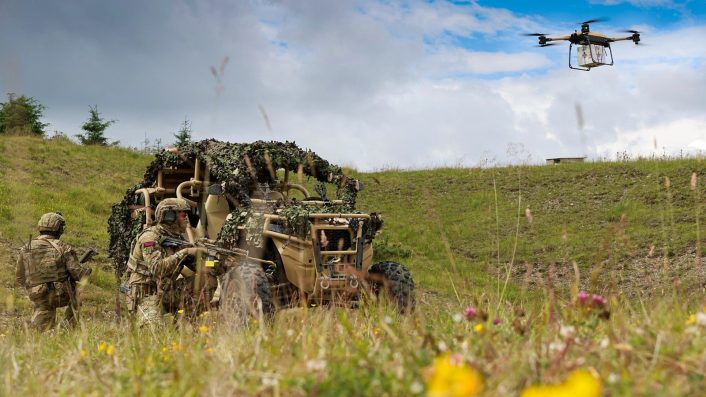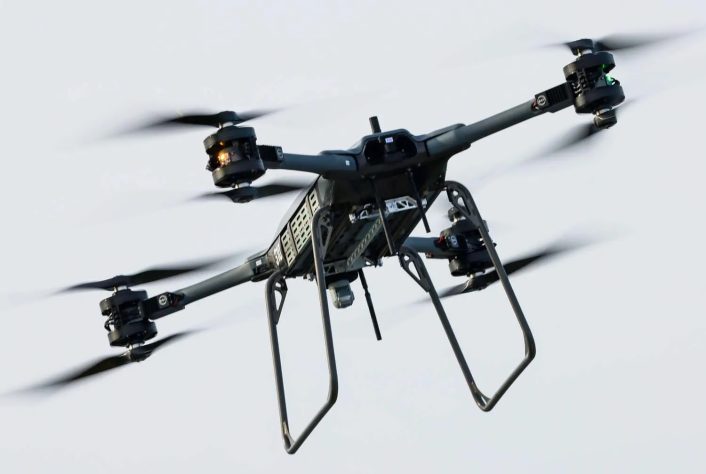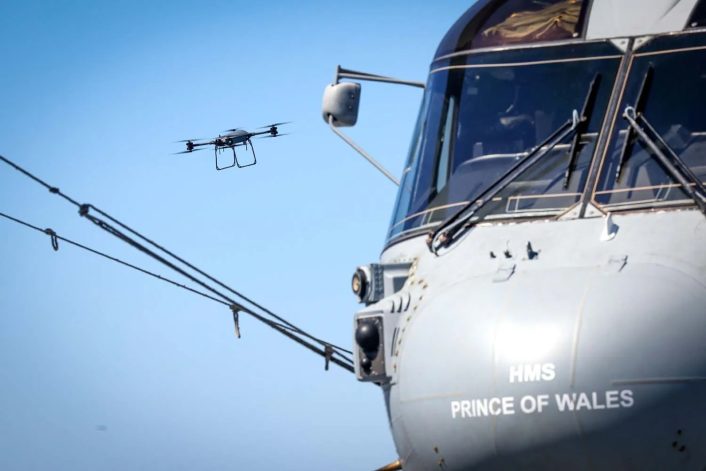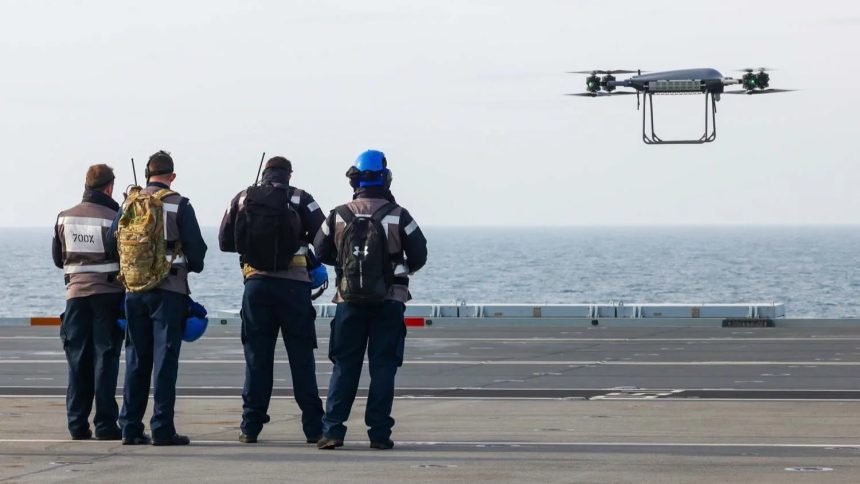Malloy’s eight-rotor T-150 logistics drone has recently been used for ship-to-ship resupply during the HMS Prince of Wales’ CSG 25 deployment.
The Royal Navy has declared the Malloy T-150 uncrewed air system (UAS) ready for front-line operations. The milestone, which moves tactical logistics closer to routine use at sea and ashore, follows two years of trials with Royal Navy and Royal Marines units.
The intensive testing included scenarios from Arctic conditions to the Indian Ocean, as well as a historic ship-to-ship delivery during the UK Carrier Strike Group 25 (CSG 25) deployment. As a result, a fleet of T-150s will be now deployed to carry ammunition, weaponry, food, personal and medical supplies to Royal Marines Commandos operating in all manner of extreme environments.
Operational readiness and capability
According to BAE Systems, which acquired Malloy Aeronautics and merged it into its FalconWorks division, the T-150 has been declared ready to “Release to Service” after a demanding program of trials with 700X Naval Air Squadron (NAS) and Commando Logistic Regiment personnel. The company said the T-150 has proved immensely valuable in rapidly bringing supplies over complex terrain, reaching places where traditional supply lines are simply unviable.
“The introduction of logistic drones represents a significant expansion in the Commando Force’s use of Uncrewed Aerial Systems, beyond those already in-service for surveillance/reconnaissance, and importantly reduces the risk to personnel during tactical re-supply,” said Brigadier Chris Haw, Head of the Commando Forces Programme. “Tested in operationally representative conditions, and developed in close collaboration with Malloy, the equipment and operators have made considerable progress. The T-150 has great potential for broader use-cases as we have recently seen in operational theatres and on the Carrier Strike deployment.”

The platform is an electric vertical take-off and landing (eVTOL) octocopter with eight rotors, an endurance reported between roughly 20 and 40 minutes – depending on payload, a top speed around 60 mph, and a maximum underslung cargo capacity of approximately 68 kg. It is operated by a two-person team – a remote pilot and a systems monitor – and can be flown either manually or autonomously to pre-programmed waypoints.
The practical effect of those numbers is straightforward: while a single T-150 cannot replace a Merlin or Wildcat helicopter for large loads or long-range transfers, its payload and endurance map well to the majority of routine carrier-group supply tasks. As we previously reported here at The Aviationist, previous carrier deployments show roughly 95% of transferred items weigh less than 50 kg – well within the T-150’s working envelope – making fleets of small drones a viable complement to manned aircraft for many resupply missions.
First ship-to-ship delivery and CSG integration
The Royal Navy released details of a historic first during the 2025 Indo-Pacific deployment, when a Malloy T-150 flew from flagship HMS Prince of Wales to destroyer HMS Dauntless. The UAS moved spare and repair parts flying autonomously for the takeoff and the sortie, and then under local control for the landing.
The trial demonstrated a one-mile transfer and highlighted the platform’s potential to free up helicopter flight hours that would otherwise be consumed by vertical replenishment (VERTREP). Captain Colin McGannity, Commander Air Group for CSG 25, framed the milestone as a step toward a hybrid carrier air wing in which unmanned systems shoulder logistics duties and free crewed helicopters for other operational tasks.

“This milestone in the Malloy trials is a step toward the vision of a fully integrated hybrid carrier air wing,” said McGannity. “By taking some of the logistics burden, Malloy will allow our naval helicopters to concentrate on their core outputs, while delivering, rapid, more efficient resupply across the whole Strike Group. The really exciting bit is that we then plan to incorporate these lessons to be able to use UAVs for many other roles, including options for warfighting.”
Operational context and drivers
The Carrier Strike Group deployment is effectively a proving ground for integrating unmanned systems into everyday naval routines. CSG 25 brought along nine Malloy T-150s with 700X NAS, alongside RQ-20 Puma ISR drones.
This could be viewed not only as part of a longer-term experiment in distributed logistics, but also as the reflection of practical constraints. In fact, Royal Fleet Auxiliary (RFA) capacity for solid stores has declined and a lack of a dedicated solid stores support vessel on the deployment increases reliance on vertical transfers.
In this environment, the agility and lower operating cost of small eVTOL cargo drones create an attractive mitigation pathway. Moreover, the use of a drone instead of a larger helicopter like the Merlin or the Wildcat spares precious limited resources on board the vessels, which would be critical in combat scenarios.

Tactical benefits and limitations
The T-150’s principal advantages are speed of delivery to complex or denied terrain, low cost per sortie relative to helicopters, and reduced risk to personnel during tactical resupply. Trials with Royal Marines Commandos showed the platform could reach locations where conventional lines of supply are unviable – a clear benefit for littoral, expeditionary and high-intensity littoral operations.
However, limitations still remain. The T-150’s payload and range are finite, and sortie cadence, sea state, deck handling and charging/recovery procedures impose operational constraints.
A drone fleet’s utility therefore depends on integration: logistics planning, robust deck handling procedures, and the availability of suitably trained operators and maintenance support. While the use of autonomy might help reduce the burden, there are limitations due to the environment that are difficult to overcome.
The recent Release to Service declaration addresses the integration dependance by confirming the platform and crews have met required standards. However, a broader fleet integration will require further doctrine, training and sustainment investment, which might be useful also for the introduction of the hybrid carrier air wing with the inclusion of combat drones.

The path ahead
Beyond logistics, we recently reported here at The Aviationist experiments that underline the platform’s modular potential. A modified variant of the T-150, known as the TRV-150, has been used in U.S. trials to carry and fire APKWS guided rockets, achieving direct hits during tests at Dugway Proving Ground.
While Malloy’s baseline UK T-150 is fielded as a cargo system, the TRV program demonstrates how the airframe can be adapted for strike or defensive roles. This factor broadens future mission sets, which could include fire support to ground units or even counter-UAS missions.
The T-150’s Release to Service is an important step, but not an end state. Wider adoption will depend on fleet-level procedures for deck operations, logistics planning and continued work on interoperability with manned aviation and shipboard handling systems.









